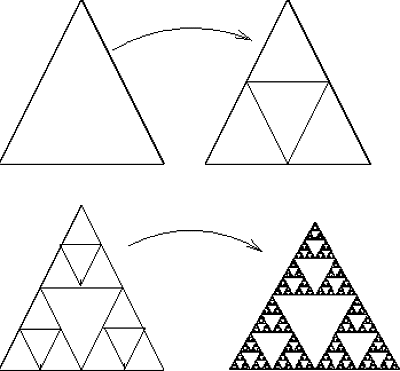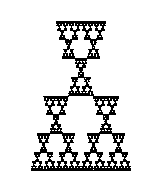
The Chaos Game is a game intended to illustrate the self similar structure of fractals. The game board is a fractal. That is, it is a shape generated by self similar mappings. The moves that the player makes correspond to the transformations that generate that fractal.
The first fractal that is used as a game board is Sierpinski's Triangle. Sierpinski's Triangle is generated by self similar mappings. That is the whole shape is shrunk in half, and then mapped into a smaller section of the shape. In the case of Sierpinski's Triangle: the greater shape is a triangle. This shape is then shrunk and mapped into the three sections of the triangle that are defined by midpoints of the greater triangle. This process can be continued on each of the smaller triangles. Each little triangle is a shrunken version of the big triangle. In fact, any little triangle you look at is a shrunken version of the big shape.

In the chaos game the moves that the player makes follow the pattern of these mappings. The player starts with red dot in the right corner of the big triangle. The way that the dot is moved is by mapping it halfway to the vertex that is clicked on. This corresponds to shrinking the whole shape to half its size, and relocating it in the corners of near the vertex that was clicked on. For example, clicking on the red vertex corresponds to shrinking the whole triangle to half it's size and relocating it in the top third of the triangle.
The goal of the player in The Chaos Game is to get the dot into a specific "target triangle" that is marked in green. The target triangle is one of the smallest triangles visible on the screen. The program selects which one randomly. Since the ways for the player to move the red dot correspond to the mappings that create the shape, there is always a way to map the red dot into the target triangle. From any point inside the big triangle, there is one specific sequence of tranformations that the the point must follow to arrive in the target triangle. Because this sequence can be started at any point in the triangle, the player can click on any buttons she wants to at first. But to win, her last moves must follow this sequence.
The other two games are a little bit trickier, though the underlying principles are exactly the same. Their defining transformations include rotations as well as shrinking. Game 2 is in the shape of a tall skinny trapezoid. The transformations that define it are slightly different from those in Game 1. First it is shrunk in half, and then the top third of it is rotated by 180 degrees. The three new shapes are placed in three corners of the trapezoid.
Once again, the way that the dots move in this game correspond to the transformations that define the shape. Clicking on one of the two bottom vertices moves the point halfway to that vertex. Clicking on the top vertex moves the point halfway to the red X, and then rotates about it by an angle of 180 degree.
Once again, because the red dot moves according to the transformations that define the shape, the winning algorithm is the same as in Game 1. Only in Game 2, it is somewhat more tricky to visualize the transformations.
The following is a picture of what the Game 2 fractal looks like:

Game 3 is in the shape of a non-regular hexagon. It is shrunk in half, and then each third is rotated by an angle of 180 degrees. In this game all the principles are the same as before. The red dot is moved halfway to a red X and then rotated by 180 degree angle. The algorithm is exactly the same.
The following is a picture of what the Game 3 fractal looks like:

 To Index
Next Page
To Index
Next Page
